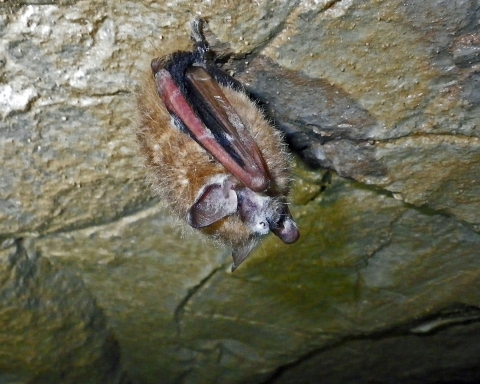Through grants from the National Science Foundation and the Paul G. Allen Family Foundation, University of Wisconsin-Madison, U.S. Geological Survey and U.S. Fish and Wildlife Service are teaming up to develop a new treatment to boost bats’ immunity to the fungus that causes white-nose syndrome as part of an all-hands-on-deck effort to battle this disease.
“This research is part of an approach to find a tool for every situation,” said Jonathan Reichard, assistant national white-nose syndrome coordinator for the Service. “As research is ongoing to refine the vaccine for white-nose syndrome, this project seeks to add a complementary treatment that may increase and extend the benefits of the vaccine. It also offers a treatment that can be delivered at a different time of year, opening additional opportunities for white-nose syndrome management.”
Using the $1.8 million National Science Foundation grant, the university’s Dr. Bruce Klein, graduate student Marcos Isidoro Ayza and their collaborators will investigate how the Pseudogymnoascus destructans fungus invades bat skin, the roles of receptor cells in this invasion, and the potential for receptor inhibitors that can prevent disease in a combination vaccine and treatment strategy.
With a $150,000 grant from the Paul G. Allen Family Foundation, the Service will test the treatment with help from field staff and state biologists in the second year of the study. The funding will pay for travel to field sites and supplement Service funds for field equipment, like harp traps and Radio Frequency Identification (RFID) tags, for partners to capture and track bats.
The treatment and vaccine work capitalizes on partnerships in creative ways. Through its white-nose syndrome program, the Service leads the effort to combat the disease, in collaboration with federal, state and tribal partners, and researchers. For this project, the Service, the Survey, and the university form a team of conservation practitioners and academic researchers with expertise and networks to advance this research to on-the-ground conservation work.
The Service offers grants to institutions and natural resource management agencies to advance disease research and identify new solutions to meet a variety of conservation challenges for hibernating bats. The experience and knowledge of these partners lays the groundwork for testing white-nose syndrome treatments in addition to other methods, including disinfecting roosts using Ultraviolet light.
White-nose syndrome affects hibernating bats and is caused by an invasive, cold-loving fungus. The fungus grows on and into bats’ skin, disturbing their hibernation and leading to dehydration, starvation and often death. First documented in New York in 2006, white-nose syndrome has since spread to at least 38 states and eight Canadian provinces and has been confirmed in 12 North American bat species.
For the researchers, the grant represents a creative partnership in and of itself. "This is a really nice way to go after a big problem of consequence," Klein said of the public-private partnership represented in the joint gift from the foundations. "NSF is interested in basic research, and the Paul Allen Foundation is interested in conservation biology. What a great marriage."
As a physician scientist who is head of pediatric infectious disease at the American Family Children's Hospital, Klein's involvement in a continent-wide effort to conserve wildlife species is perhaps at first blush a little unexpected. Klein’s work studying other fungal pathogens that affect people, like blastomycosis, led him to wildlife work. In his long-term research, Klein studies how fungi interact with the immune systems of mammals. His laboratory testing, in partnership with the National Wildlife Health Center and others at the university, showed that his blastomycosis vaccine would likely stimulate cellular immunity in bats and potentially protect against the white-nose syndrome fungus.
The work of their collaborator at the Survey, Dr. Tonie Rocke, set the stage for Klein and Isidoro Ayza’s research. Rocke’s 40 years of wildlife disease research includes a vampire bat rabies vaccine. Working for years on a white-nose syndrome vaccine, Rocke says this method for reducing fungal loads works in concert with a vaccination that has already been tested in the field and lab.
Rocke is excited to try Klein and Isidoro Ayza’s treatment in the field as part of this multipronged approach. "Not all tools work for all species or all regions,” she added. “You have to tailor the goals to every region and every species.”
Klein and Isidoro Ayza’s plan has demonstrated promise in Isidoro Ayza’s early laboratory work. "We are making very fast progress developing these tools," said Isidoro Ayza.
Logistical barriers to vaccinating and treating wild bats are challenging, and it will likely take several more years of laboratory and field work to arrive at a realistic strategy for protecting North America's hibernating bats. Doing so will take continued dedication of partners, as well as innovation. At the very least, though, the hope of the Service, Klein, Isidoro Ayza and our partners is that the newly funded research will help develop and refine strategies for protecting vulnerable bat populations.
More information regarding white-nose syndrome can be found at: www.whitenosesyndrome.org
Information about how USGS is addressing white-nose syndrome: https://www.usgs.gov/centers/nwhc/science/white-nose-syndrome
The NSF announcement can be found at https://www.nsf.gov/news/news_summ.jsp?=y&cntn_id=306871&org=BIO






